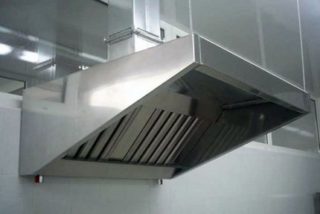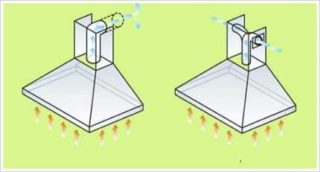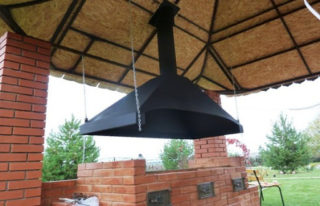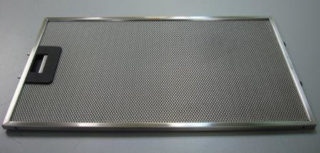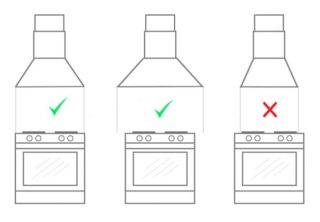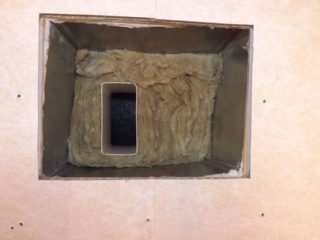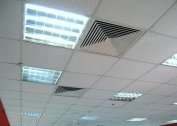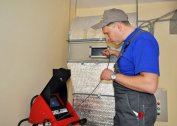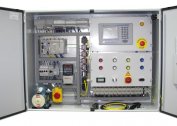An exhaust hood is a necessary element of the ventilation system, with the help of which it is possible to completely remove the smells of burning and food from the kitchen. Structurally, the umbrella is a dome, which is located above the furnace. Inside the exhaust element there are grease traps (special filters), which are installed at an angle of 45 degrees. Professional models include spark arrester grids, fans, and even lights.
Materials for the manufacture of an exhaust hood for the kitchen
For the manufacture of the kitchen dome, two types of steel are used:
- stainless;
- galvanized.
The thickness of the material varies from 0.5 to 1 mm.
Both types of material are hygienic and resistant to aggressive environments. At the same time, galvanized steel will cost the buyer a little cheaper than stainless steel. A corrosion-resistant exhaust hood made of galvanized steel gives the anticorrosive properties a thin layer of zinc on top. In addition, such elements can be painted in any color.
Stainless steel equipment features enhanced performance:
- not afraid of deformations;
- It has no cracks and pores of the metal, is not prone to the multiplication of bacteria on the inner walls.
For the manufacture of stainless steel umbrellas, two types of steel are used:
- AISI 430. This is a ferritic steel that is resistant to temperature extremes. Umbrellas made of this material can be matte, mirrored or polished.
- AISI 304. Steel is low carbon. It is steady against hostile environment (acids, alkalis) and extremely high temperatures. Often withstands up to +900 degrees. Therefore, stainless steel ventilation umbrellas are more often used in the food industry, in catering establishments and in chemical laboratories.
Both types of material are not subject to corrosion.
Varieties of exhaust umbrellas
All exhaust hoods for the ventilation system are classified into several types.
According to the principle of work
There are two types of dome installations:
- Exhaust. They work only to remove polluted air from the room. Act on the principle of suction of contaminated air masses and their transportation to the duct. For the exhaust element, a separate supply air ventilation system is required in the room.
- Supply and exhaust. These designs cope with the removal of dirty air from the room and with the supply of fresh back. Such devices are especially relevant for professional kitchens. They allow you to remove from the room burning and food odors, as well as increased humidity.
In the supply and exhaust versions of the umbrellas, the exhaust function prevails over the inflow function.
By appointment
Umbrellas for ventilation can be domestic and industrial. The first have a wall design, since the stove in the house is mainly located against the wall. Household models are equipped with simple filters made of special paper.
Industrial umbrellas have impressive dimensions, a wide variety of grease filters, spark arrestor mesh, etc.
By type of construction
Wall and island umbrellas are distinguished. The first option is to be installed only at one of the walls of the kitchen. The second allows you to place it in any area of the kitchen under the ceiling, strictly above the stove. More often, for complete ventilation of the kitchen, island models are mounted in the center of the room together with the hob.
There is also an exhaust hood transition.Outwardly, it has the shape of a truncated cone or pyramid. Mounted over open fires.
By type of installation
The hood hood can be:
- Recessed. As a rule, these are household models. They are mounted in the lower part of the kitchen cabinet. Such models are especially convenient for maintaining the overall interior of the kitchen and its proportions. The umbrella and the exhaust pipe are not visible to the prying eye due to the cabinet.
- Flat. Outwardly they do not even resemble an exhaust hood. They work on the principle of air recirculation, cleaning dirty and feeding it back into the room. Flat umbrellas have a minimum capacity and can be used only for domestic purposes.
- Dome. These are the very industrial umbrellas that can cope with large volumes of polluted air. They have high power. Often even equipped with a filter pollution control system and a remote control.
For domestic use, it is better to choose an umbrella for the interior design of the kitchen.
Advantages and disadvantages
Corrosion-proof and galvanized exhaust hood have several advantages:
- resistance to wet environments and corrosion;
- inertness to temperature extremes;
- resistance to mechanical stress, lack of deformation even despite the small thickness of the sheet;
- heat resistance;
- Relatively light weight without the risk of heavier ceilings or walls.
- inertness to aggressive environments (acids, alkalis, etc.).
A relative disadvantage is the need for regular replacement of grease traps. But without them, the ventilation system will not work fully.
Specifications
Industrial hood hood refers to professional equipment. Therefore, it is evaluated by such technical characteristics:
- Material of manufacture: galvanized or stainless steel.
- Dimensions: diameter of the exhaust pipe, dome height, dome dimensions. More often, for the ZVO (oval or round umbrella), the cross section of the exhaust pipe is 350 mm, for the ZVP (rectangular umbrella) - 250 mm. The width of the dome is from 50 to 120 cm. There are also individual orders for the manufacture of an exhaust dome with larger or smaller parameters according to customer drawings.
- Total weight
- Functionality: exhaust or supply and exhaust.
- Power.
The manufacturer indicates all the technical characteristics of the exhaust dome on the factory packaging.
How to choose an exhaust hood
The selection of the exhaust dome is based on several important parameters. First of all, it is necessary to determine the purpose of the equipment - domestic or industrial. For a home dome, everything is relatively clear - choose according to the size of the plate and design, as well as according to the principle of operation (recirculation or compatible with the ventilation shaft).
For professional domes, the choice is based on such criteria:
- Appointment - an exhaust or supply and exhaust umbrella.
- Location: wall or ceiling. If the hob is located in the center of the kitchen, it is better to take an island supply and exhaust umbrella. For stoves located against the wall, you need to take a wall-mounted exhaust hood with a grease trap.
- The size of the dome. According to standards, it should protrude 15-20 cm beyond the hob on each side.
- The height of the dome and its performance. If you compare approximately the same umbrellas (according to the size of the cross-section of the filters), the productivity will be higher for the equipment that is higher. The optimum height for hanging the dome from the floor level is 2.0 m. Therefore, with high ceilings in the room, the height of the dome should correspond to them.
- The power of the umbrella. To determine it, you can use the simple method. From the technical data sheet of the hob, specify the power of each stove or burner. Sum them up.Thus, the desired power of the equipment is determined. If necessary, rounding is done in a slightly larger direction.
- The number of connected ducts. For a household model, one is enough. For industrial lengths from 160 cm - 4 are needed (2 for the hood and 2 for the inflow).
- Noise level. Optimal for humans is noise up to 40 dB. If the manufacturer indicates a larger parameter, you will have to install noise absorbers.
The rest of the exhaust hoods are selected according to additional options - the ability to remotely control, lights, etc. For foci with open fire, a dome with a spark extinguishing grid is required.
Nuances of self-assembly
Installation of the exhaust dome is done in several ways. Which one to choose depends on the model of equipment.
- Installation on wall anchors. For this, 2-3 holes are drilled in the rear wall of the dome at an equal distance and the device is fixed to the wall. In this case, the panel should be perfectly flat. If the umbrella has a large overhang of the dome (more than 1 m), you can additionally attach it to the ceiling.
- Mounting on cables and chains. To do this, brackets must be welded to the top of the dome in 3 or 4 places, depending on the shape of the umbrella. Also, the brackets are mounted in the ceiling. The dome is suspended on cables or chains to the desired height. This installation method is shaky. The dome remains moderately mobile.
- Mounting on studs and collets. This method can be used to mount island and wall models. This method is suitable for rooms with a ceiling height of not more than 4.35 m due to the standard length of a hairpin of 2 m. To install the dome at four points, drill holes at the edges or weld ears (loops) under the studs F8 - F10 mm. In this case, the studs are fixed in advance to the ceiling. It remains to connect all the elements by raising the umbrella to the desired height.
- Mounting on support frames. They are initially welded, based on the dimensions of the lower part of the dome (its cross section). It is advisable to cook stainless steel frames. The finished frame is installed on the floor, securely fixed and then an exhaust hood is supported on it.
If you have doubts about your abilities when installing an exhaust hood, it is better to invite a specialist. The wizard will help with the selection of equipment, its installation and further maintenance.
